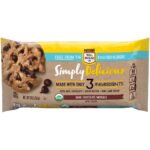Tired of the same old sandwich routine, especially when allergies complicate things? This guide explodes the myth that delicious and allergy-safe lunches are mutually exclusive. Prepare to embark on a culinary adventure, discovering vibrant bread alternatives that boast surprising textures and flavors, from the subtly sweet embrace of rice cakes to the hearty chew of gluten-free wraps. We’ll unveil a treasure trove of creative fillings, ranging from zesty vegetarian delights to protein-packed vegan options, all meticulously crafted to avoid common allergens. Imagine sinking your teeth into a vibrant bell pepper boat overflowing with a colorful, allergy-friendly salad, or relishing the refreshing crunch of a cucumber cup brimming with flavorful hummus. Get ready to transform your lunch break into a celebration of taste and safety.
We’ll explore innovative sandwich structures that go beyond traditional bread, providing alternatives that are both visually appealing and nutritionally sound. Learn how to select and prepare allergy-safe condiments and spreads that elevate your creations to the next level. Finally, we’ll provide a step-by-step recipe for a complete allergy-safe sandwich, ensuring a delicious and worry-free meal every time. Get ready to redefine your idea of the perfect sandwich!
Top 5 Allergy-Friendly Bread Alternatives
Finding delicious and safe bread alternatives can be a challenge for those with various allergies, but thankfully, many options exist that cater to diverse dietary needs. These alternatives offer a similar texture and taste to traditional wheat bread, without compromising on nutritional value or flavor. They are suitable for individuals avoiding gluten, dairy, soy, and other common allergens.
Top 5 Allergy-Friendly Bread Alternatives
Choosing the right bread alternative depends on individual allergies and preferences. The following table summarizes five excellent options, highlighting their suitability for different allergies and nutritional benefits. Remember to always check ingredient labels to ensure they meet your specific dietary requirements.
| Bread Alternative | Allergy Suitability | Nutritional Highlights | Recipe Source/Link (if applicable) |
|---|---|---|---|
| Rice Bread | Gluten-free, dairy-free, soy-free | Good source of carbohydrates, provides energy. Often fortified with added vitamins and minerals. | Many recipes available online; search “gluten-free rice bread recipe”. |
| Cassava Bread | Gluten-free, dairy-free, soy-free | High in carbohydrates, provides energy. Naturally gluten-free and often low in fat. | Numerous recipes can be found online; search “cassava bread recipe”. |
| Coconut Flour Bread | Gluten-free, dairy-free (depending on recipe), soy-free | Good source of fiber, high in manganese. Naturally sweet flavor. | Many recipes available online; search “gluten-free coconut flour bread recipe”. |
| Quinoa Bread | Gluten-free, dairy-free, soy-free | Complete protein source, high in fiber and iron. Offers a slightly nutty flavor. | Search online for “gluten-free quinoa bread recipe” for various options. |
| Potato Bread | Gluten-free, dairy-free (depending on recipe), soy-free | Good source of carbohydrates, potassium, and vitamin C. Can be dense and moist. | Numerous recipes available online; search “gluten-free potato bread recipe”. |
Texture and Taste Comparisons
Rice bread often has a slightly soft and fluffy texture, though it can be more crumbly than wheat bread. Its taste is relatively mild and neutral, making it versatile for various sandwiches and toppings. Cassava bread tends to be slightly denser and chewier than wheat bread, with a slightly sweet and earthy flavor. Coconut flour bread is generally more delicate and crumbly, with a distinct coconut flavor that complements sweet and savory fillings. Quinoa bread boasts a slightly grainy texture and a mild, nutty taste. Potato bread, depending on the recipe, can range from fluffy and light to dense and moist, with a subtle potato flavor.
Preparation Methods and Allergy Considerations
When preparing these bread alternatives, meticulous attention to cross-contamination is crucial for allergy sufferers. Use separate cutting boards, utensils, and mixing bowls to prevent accidental exposure to allergens. For those with nut allergies, ensure that all ingredients are certified nut-free. When using coconut flour, remember that it absorbs a significant amount of liquid, so adjust the recipe accordingly. Always read ingredient labels carefully to confirm the absence of allergens and check for any potential cross-contamination warnings.
Step-by-Step Guide to Creating an Allergy-Safe Sandwich

Creating an allergy-safe sandwich requires careful attention to ingredients and preparation techniques to prevent cross-contamination. This guide provides a detailed recipe for a delicious and safe sandwich suitable for individuals with common food allergies. The focus is on clear instructions and visual descriptions to ensure a successful and enjoyable experience.
Ingredients for an Allergy-Safe Turkey and Avocado Sandwich
This recipe uses readily available ingredients and can be easily adapted to suit various dietary needs and preferences. Remember to always check ingredient labels for potential allergens.
- 2 slices allergy-friendly bread (e.g., rice bread, gluten-free bread). Imagine two perfectly golden-brown slices, slightly crisp on the edges, radiating a subtle warmth.
- 2-3 slices roasted turkey breast, thinly sliced. Picture succulent, tender slices of turkey, a light pink hue, glistening slightly from the roasting process.
- ½ ripe avocado, mashed. Visualize a creamy, vibrant green avocado paste, smooth and rich in texture.
- 1 tablespoon mayonnaise (ensure it’s allergen-free). Imagine a dollop of creamy, white mayonnaise, smooth and glossy.
- Lettuce leaves (ensure they are washed thoroughly). Picture crisp, vibrant green lettuce leaves, fresh and clean.
- Salt and pepper to taste. Imagine fine grains of salt and pepper, ready to enhance the flavors of the sandwich.
Sandwich Preparation
This section Artikels the step-by-step process of assembling the sandwich, emphasizing cleanliness and prevention of cross-contamination.
- Prepare the work surface: Begin by thoroughly cleaning your work surface with soap and water. Imagine a sparkling clean counter, ready for food preparation. Then, lay down a clean paper towel or a cutting board to create a dedicated space for your sandwich assembly.
- Assemble the sandwich: Spread the allergen-free mayonnaise evenly on both slices of bread. Visualize a thin, even layer of creamy white mayonnaise, covering the entire surface of each bread slice. Next, layer the lettuce leaves on one slice of bread. Picture crisp, green lettuce leaves neatly arranged on the bread. Then, add the turkey slices, followed by the mashed avocado. Imagine the turkey and avocado layered neatly on the lettuce. Season with salt and pepper to taste. Finally, top with the other slice of bread. Visualize the completed sandwich, a beautiful and appetizing creation.
- Cut and serve: Carefully cut the sandwich in half diagonally, creating two triangular halves. Imagine the knife slicing cleanly through the sandwich, revealing a layered interior of turkey, avocado, and lettuce. Serve immediately for optimal flavor and texture.
Storage and Serving Suggestions
Proper storage is crucial to maintain the sandwich’s freshness and safety.
For optimal freshness, consume the sandwich immediately after preparation. If storage is necessary, wrap the sandwich tightly in plastic wrap or place it in an airtight container. Store in the refrigerator and consume within 24 hours. Imagine the sandwich safely stored, maintaining its freshness and deliciousness for later enjoyment. Serving suggestions include pairing the sandwich with a side salad or some fruit for a complete and balanced meal.
Crafting allergy-safe sandwiches doesn’t have to be a chore; it can be a fun and creative culinary journey! With the knowledge and inspiration gained from this guide, you’ll be empowered to create a diverse range of delicious and safe lunches. From exploring the versatility of bread alternatives to mastering the art of innovative sandwich structures, you’ll find yourself experimenting with new flavors and textures, confidently preparing meals that are both healthy and satisfying for yourself and your loved ones. So ditch the boring, allergy-laden sandwiches and embrace a world of flavor, freedom, and delicious possibilities!
User Queries
Can I freeze allergy-safe sandwiches?
Yes, many allergy-safe sandwiches freeze well. Wrap them tightly in plastic wrap and then foil to prevent freezer burn. Thaw overnight in the refrigerator before serving.
How can I avoid cross-contamination when preparing allergy-safe sandwiches?
Use separate cutting boards and utensils for allergy-safe ingredients. Thoroughly clean and sanitize all surfaces before and after preparing the sandwiches.
What are some good sources for allergy-safe ingredients?
Check labels carefully for allergen information. Look for certified gluten-free, dairy-free, or other allergy-specific certifications. Health food stores and online retailers specializing in allergy-friendly products are excellent resources.
How long can I store an allergy-safe sandwich in the refrigerator?
Ideally, consume allergy-safe sandwiches within 1-2 days of preparation to maintain freshness and prevent bacterial growth.


